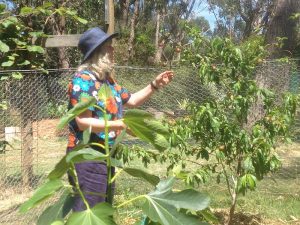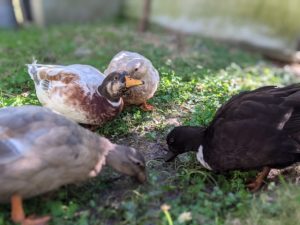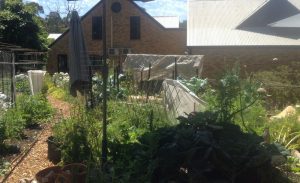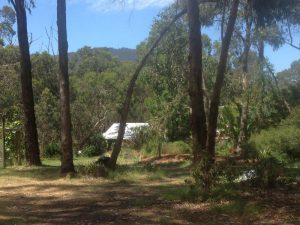Jenny Husselbee – a permie from Mooroolbark
Ann Stanley visits the garden of Jenny Husselbee, from Mooroolbark.
Two permies and friends from Mooroolbark
People of Mooroolbark! You have inspiring people among you. Of course, you already know this(!) but you may not know these two people: Jenny Husselbee and Claire Smith have both established productive permaculture gardens on challenging sites in Mooroolbark, Jenny on clay soil near the site of the Montrose brickworks and Claire on boggy land not far from where Lilydale Toppings were sourced. Neither garden is on prime agricultural land but both sites produce significant amounts of food, proving that, with some attention to your site’s deficits and working with the natural supplies of light, water and soil, a garden can be productive. Both gardens showcase the permaculture approach to food growing, which is based on the integration of plant, animal and community resources.
I met Jenny and Claire at Claire’s home on a sunny morning in spring. We began our discussion about food growing and permaculture, free ranging around the topics of community, animals, produce, pests, permaculture principles, water and soil. We took a tour of Claire’s permaculture garden, then we drove to Jenny’s place, where we continued our conversation while strolling in the grounds of the 4½ acre block where Jenny lives with her family.
This article is about Jenny’s garden. Here is the link to the article about Claire’s garden.
Jenny’s garden
 Long committed to producing food locally and developing strong resilient communities, Jenny completed her Permaculture Design Certificate (PDC) 20 years ago at the Kallista Community House with Jane Scott. You can read about Jane Scott, who has now passed away, in the book Permaculture Pioneers: Stories from the New Frontier, edited by Caroline Smith and Kerry Dawborn.
Long committed to producing food locally and developing strong resilient communities, Jenny completed her Permaculture Design Certificate (PDC) 20 years ago at the Kallista Community House with Jane Scott. You can read about Jane Scott, who has now passed away, in the book Permaculture Pioneers: Stories from the New Frontier, edited by Caroline Smith and Kerry Dawborn.
Jenny’s property is a model of permaculture zoning with an extensive, visually beautiful kitchen garden near the house, the enclosed orchard a little further away and wilder areas beyond that.
The wild areas are important as Jenny is keen on indigenous and native vegetation, in particular edible plants, to support a wide range of wildlife such as birds, frogs and lizards.  She is part of a program called Ribbons of Green run by Yarra Ranges Shire, which aims to plant 60,000 native plants each year, and will soon be receiving 400 tube stock plants to be used on the property.
She is part of a program called Ribbons of Green run by Yarra Ranges Shire, which aims to plant 60,000 native plants each year, and will soon be receiving 400 tube stock plants to be used on the property.
From the driveway of the house, you can follow a recently planted hedge of citrus trees to a large, enclosed orchard modelled on the design of Peter Allen of Telopea Mtn Permaculture & Nursery in Monbulk and constructed by Dean and Troy of Twin Hives Garden & Permaculture. Jenny keeps a small flock of ducks in the orchard. Here they live, safe from predators, eating insects and fertilising the soil. Jenny tells me that ducks forage with their beaks and do not scratch the ground as chickens do, so they do not damage the roots of the trees.
 On the property grow an impressive number of fruit trees including early, mid and late season varieties. There are plums (Greengage, Satsuma, Donsworth, D’argen & Mariposa varieties), apricots, apples, several varieties of nectarine, figs, nashi pears, medlars, peaches, plumcot, apricots, cherries, pears, kiwi vines and avocado. There are elderberries, a variety of citrus fruits, rhubarb, raspberries, strawberries, blueberries, persimmon and passionfruit. Luckily Jenny takes creative pleasure in freezing, drying and preserving food, a way of coping with abundant harvests!
On the property grow an impressive number of fruit trees including early, mid and late season varieties. There are plums (Greengage, Satsuma, Donsworth, D’argen & Mariposa varieties), apricots, apples, several varieties of nectarine, figs, nashi pears, medlars, peaches, plumcot, apricots, cherries, pears, kiwi vines and avocado. There are elderberries, a variety of citrus fruits, rhubarb, raspberries, strawberries, blueberries, persimmon and passionfruit. Luckily Jenny takes creative pleasure in freezing, drying and preserving food, a way of coping with abundant harvests!
Near the back door is an extensive kitchen garden, constructed with both productivity and beauty in mind, with a mixture of raised beds and fenced enclosures. In the first few months of this year (2021), Jenny’s household has harvested tomatoes, beans,  zucchini, basil, cucumbers, beetroot, carrots, lettuce, kale, silverbeet, the last of the brassicas and many herbs.
zucchini, basil, cucumbers, beetroot, carrots, lettuce, kale, silverbeet, the last of the brassicas and many herbs.
The house is oriented North-South and is powered by 4½ kW of solar panels that keep the household in credit for electric power in summer. On the property is a large dam and 128,000 litres of water tanks. Water collected from the pathways around the house feeds into a drain which leads into two of the tanks. These in turn flow into the dam. Water is also collected from the roof.
There are two beehives, a flow hive and a regular hive.
Adjacent to a shady seating area is the swimming pool which has been drained and is transitioning to a natural pond into which fish will be introduced and water plants grown. The edible water plants include water parsley, variegated water parsley, water celery, water chestnuts and taro.
As a person who enjoys challenges, Jenny loves the whole philosophy of permaculture which is based on careful observation of all the natural and human elements impacting a house and garden and  responsive problem solving with manageable, sustainable solutions. Where she is situated in Mooroolbark, food growing is challenged by rabbits, foxes, slaters, weeds and poor soil and of course there are always seasonal mysteries such as why with the bantam corn is not thriving despite it being in a wicking bed.
responsive problem solving with manageable, sustainable solutions. Where she is situated in Mooroolbark, food growing is challenged by rabbits, foxes, slaters, weeds and poor soil and of course there are always seasonal mysteries such as why with the bantam corn is not thriving despite it being in a wicking bed.
In a recent storm, Jenny and her husband lost a lot of trees. Some of the fallen timber was mulched, keeping much of this precious resource on the site where it grew. Some was kept for firewood and one large tree was given to another permie who does not have their own source of firewood. This is ‘Earth Care’, ‘People Care’ and ‘Fair Share’,  the three fundamental principles of permaculture, in action.
the three fundamental principles of permaculture, in action.
You can meet Jenny at the monthly Mooroolbark Urban Harvests, where she shares her produce with Claire and others. Food swaps, she says, are great for “encouraging food growing and sharing knowledge with each other.“
